Abstract
Selected anaerobic bacterial groups in cecal and colonic contents of clinically healthy pigs fed a corn-soybean meal production diet were determined at sacrifice after 4, 8, and 11 weeks on feed, corresponding to intervals within the growing-finishing growth period. By using ruminal fluid-based media, the densities of the culturable anaerobic population; the cellulolytic, pectin-fermenting, pectin-hydrolyzing, xylan-fermenting; and the xylan-hydrolyzing, sulfate-reducing, and methanogenic bacterial populations were estimated. An analysis of variance was performed on these bacterial group variables to examine the effects of phase (weeks on feed), site (cecum or colon), or the interaction of phase with site. The population of total anaerobic bacteria was twice as dense in the colon as it was in the cecum (2 x 10(10) versus 1 x 10(10)/g [wet weight]; P = 0.001). The proportion of cellulolytic bacteria was lower at 4 weeks on feed than at 8 or 11 weeks (23 versus 32%; P = 0.026), while the proportion of pectin-fermenting bacteria depended on the interaction of phase with site (P = 0.021). The numbers of sulfate-reducing bacteria were significantly higher in the colon than in the cecum (6 x 10(7) versus 3 x 10(7); P = 0.014), as were methanogenic bacteria (19 x 10(7) versus 0.6 x 10(7); P = 0.0002). The remaining bacterial groups were stable with respect to phase and site. The results suggest that except for density differences, the microbial communities of the pig cecum and colon are similar in composition throughout the growing-finishing phase.
Full text
PDF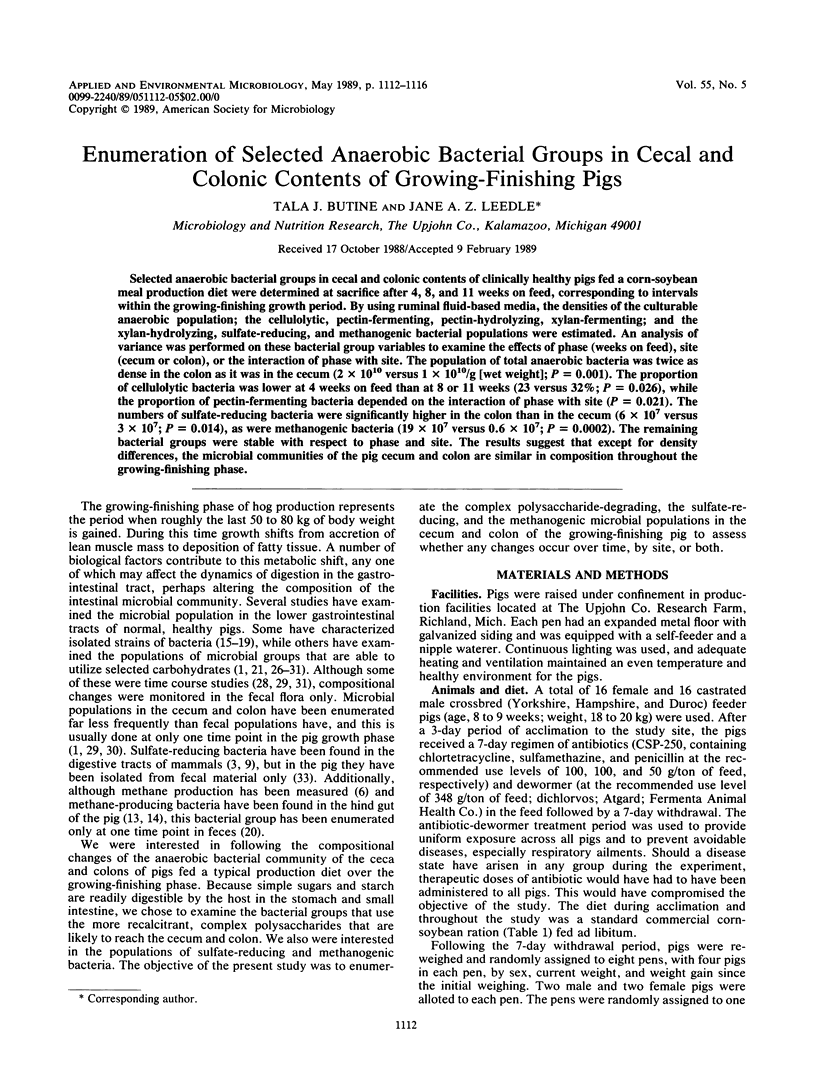
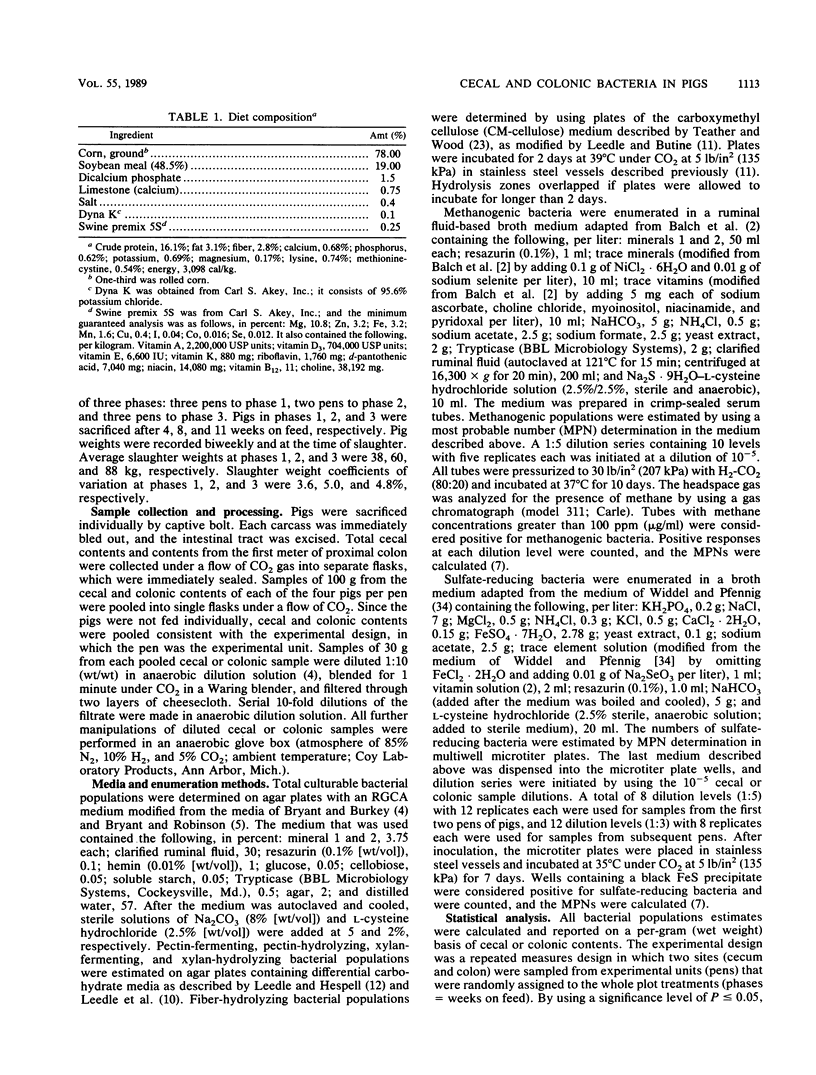
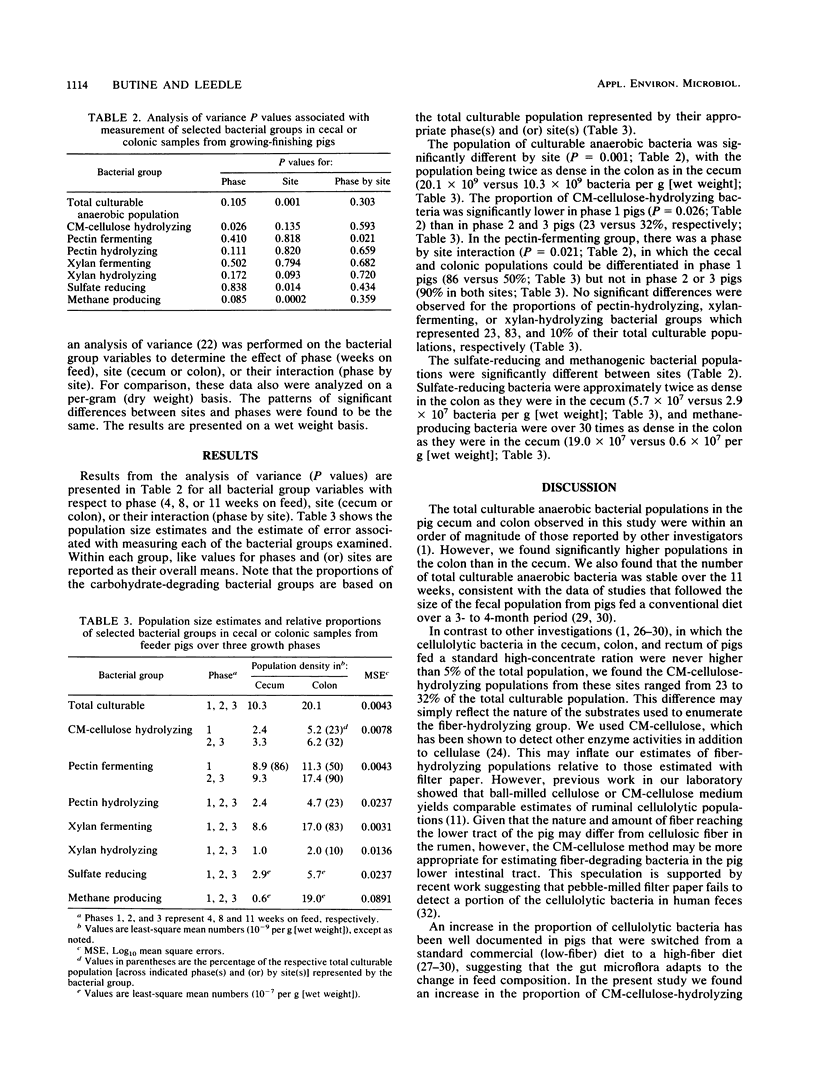
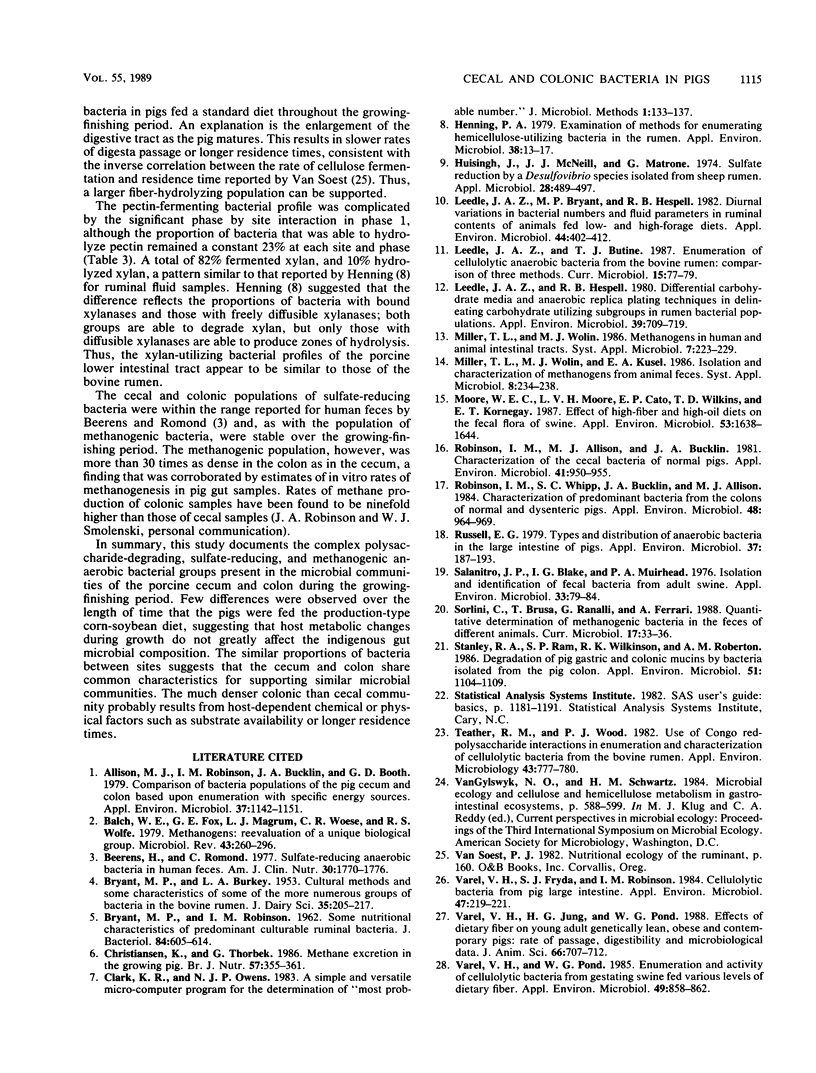
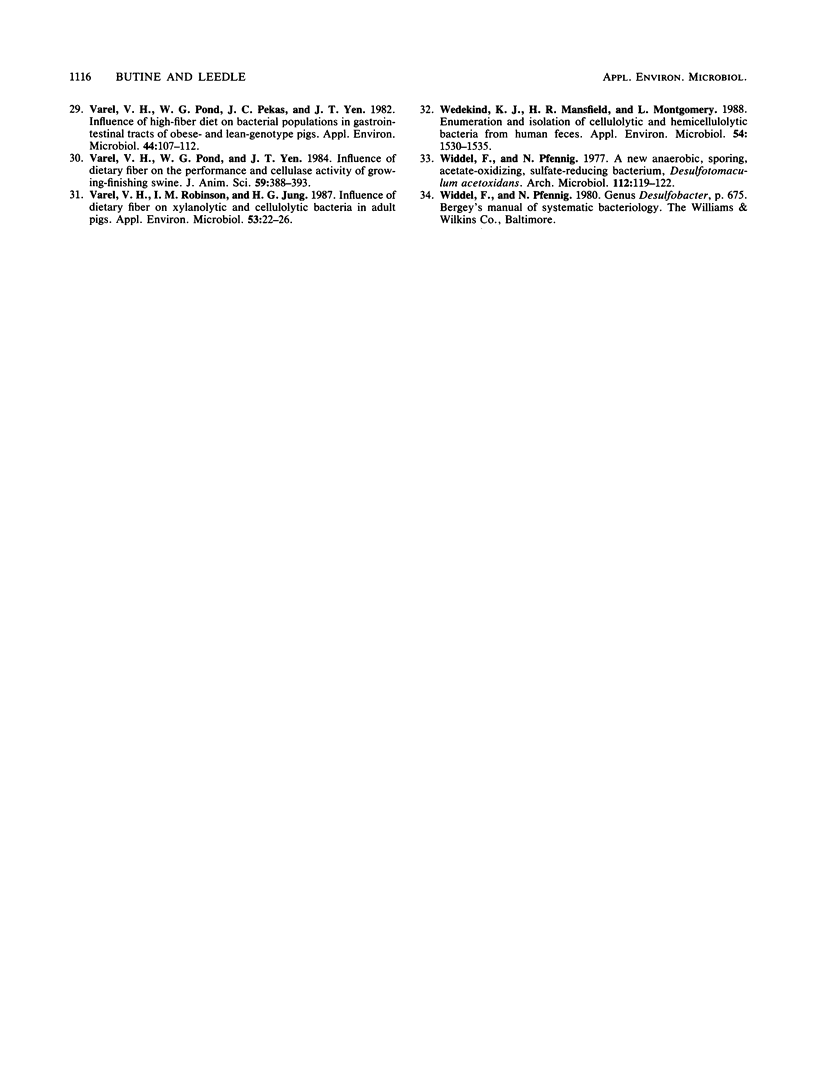
Selected References
These references are in PubMed. This may not be the complete list of references from this article.
- Allison M. J., Robinson I. M., Bucklin J. A., Booth G. D. Comparison of bacterial populations of the pig cecum and colon based upon enumeration with specific energy sources. Appl Environ Microbiol. 1979 Jun;37(6):1142–1151. doi: 10.1128/aem.37.6.1142-1151.1979. [DOI] [PMC free article] [PubMed] [Google Scholar]
- BRYANT M. P., ROBINSON I. M. Some nutritional characteristics of predominant culturable ruminal bacteria. J Bacteriol. 1962 Oct;84:605–614. doi: 10.1128/jb.84.4.605-614.1962. [DOI] [PMC free article] [PubMed] [Google Scholar]
- Balch W. E., Fox G. E., Magrum L. J., Woese C. R., Wolfe R. S. Methanogens: reevaluation of a unique biological group. Microbiol Rev. 1979 Jun;43(2):260–296. doi: 10.1128/mr.43.2.260-296.1979. [DOI] [PMC free article] [PubMed] [Google Scholar]
- Beerens H., Romond C. Sulfate-reducing anaerobic bacteria in human feces. Am J Clin Nutr. 1977 Nov;30(11):1770–1776. doi: 10.1093/ajcn/30.11.1770. [DOI] [PubMed] [Google Scholar]
- Christensen K., Thorbek G. Methane excretion in the growing pig. Br J Nutr. 1987 May;57(3):355–361. doi: 10.1079/bjn19870043. [DOI] [PubMed] [Google Scholar]
- Henning P. A. Examination of methods for enumerating hemicellulose-utilizing bacteria in the rumen. Appl Environ Microbiol. 1979 Jul;38(1):13–17. doi: 10.1128/aem.38.1.13-17.1979. [DOI] [PMC free article] [PubMed] [Google Scholar]
- Huisingh J., McNeill J. J., Matrone G. Sulfate reduction by a Desulfovibrio species isolated from sheep rumen. Appl Microbiol. 1974 Sep;28(3):489–497. doi: 10.1128/am.28.3.489-497.1974. [DOI] [PMC free article] [PubMed] [Google Scholar]
- Leedle J. A., Bryant M. P., Hespell R. B. Diurnal variations in bacterial numbers and fluid parameters in ruminal contents of animals fed low- or high-forage diets. Appl Environ Microbiol. 1982 Aug;44(2):402–412. doi: 10.1128/aem.44.2.402-412.1982. [DOI] [PMC free article] [PubMed] [Google Scholar]
- Leedle J. A., Hespell R. B. Differential carbohydrate media and anaerobic replica plating techniques in delineating carbohydrate-utilizing subgroups in rumen bacterial populations. Appl Environ Microbiol. 1980 Apr;39(4):709–719. doi: 10.1128/aem.39.4.709-719.1980. [DOI] [PMC free article] [PubMed] [Google Scholar]
- Moore W. E., Moore L. V., Cato E. P., Wilkins T. D., Kornegay E. T. Effect of high-fiber and high-oil diets on the fecal flora of swine. Appl Environ Microbiol. 1987 Jul;53(7):1638–1644. doi: 10.1128/aem.53.7.1638-1644.1987. [DOI] [PMC free article] [PubMed] [Google Scholar]
- Robinson I. M., Allison M. J., Bucklin J. A. Characterization of the cecal bacteria of normal pigs. Appl Environ Microbiol. 1981 Apr;41(4):950–955. doi: 10.1128/aem.41.4.950-955.1981. [DOI] [PMC free article] [PubMed] [Google Scholar]
- Robinson I. M., Whipp S. C., Bucklin J. A., Allison M. J. Characterization of predominant bacteria from the colons of normal and dysenteric pigs. Appl Environ Microbiol. 1984 Nov;48(5):964–969. doi: 10.1128/aem.48.5.964-969.1984. [DOI] [PMC free article] [PubMed] [Google Scholar]
- Russell E. G. Types and distribution of anaerobic bacteria in the large intestine of pigs. Appl Environ Microbiol. 1979 Feb;37(2):187–193. doi: 10.1128/aem.37.2.187-193.1979. [DOI] [PMC free article] [PubMed] [Google Scholar]
- Salanitro J. P., Blake I. G., Muirhead P. A. Isolation and identification of fecal bacteria from adult swine. Appl Environ Microbiol. 1977 Jan;33(1):79–84. doi: 10.1128/aem.33.1.79-84.1977. [DOI] [PMC free article] [PubMed] [Google Scholar]
- Stanley R. A., Ram S. P., Wilkinson R. K., Roberton A. M. Degradation of pig gastric and colonic mucins by bacteria isolated from the pig colon. Appl Environ Microbiol. 1986 May;51(5):1104–1109. doi: 10.1128/aem.51.5.1104-1109.1986. [DOI] [PMC free article] [PubMed] [Google Scholar]
- Teather R. M., Wood P. J. Use of Congo red-polysaccharide interactions in enumeration and characterization of cellulolytic bacteria from the bovine rumen. Appl Environ Microbiol. 1982 Apr;43(4):777–780. doi: 10.1128/aem.43.4.777-780.1982. [DOI] [PMC free article] [PubMed] [Google Scholar]
- Varel V. H., Fryda S. J., Robinson I. M. Cellulolytic bacteria from pig large intestine. Appl Environ Microbiol. 1984 Jan;47(1):219–221. doi: 10.1128/aem.47.1.219-221.1984. [DOI] [PMC free article] [PubMed] [Google Scholar]
- Varel V. H., Jung H. G., Pond W. G. Effects of dietary fiber of young adult genetically lean, obese and contemporary pigs: rate of passage, digestibility and microbiological data. J Anim Sci. 1988 Mar;66(3):707–712. doi: 10.2527/jas1988.663707x. [DOI] [PubMed] [Google Scholar]
- Varel V. H., Pond W. G. Enumeration and activity of cellulolytic bacteria from gestating swine fed various levels of dietary fiber. Appl Environ Microbiol. 1985 Apr;49(4):858–862. doi: 10.1128/aem.49.4.858-862.1985. [DOI] [PMC free article] [PubMed] [Google Scholar]
- Varel V. H., Pond W. G., Pekas J. C., Yen J. T. Influence of high-fiber diet on bacterial populations in gastrointestinal tracts of obese- and lean-genotype pigs. Appl Environ Microbiol. 1982 Jul;44(1):107–112. doi: 10.1128/aem.44.1.107-112.1982. [DOI] [PMC free article] [PubMed] [Google Scholar]
- Varel V. H., Pond W. G., Yen J. T. Influence of dietary fiber on the performance and cellulase activity of growing-finishing swine. J Anim Sci. 1984 Aug;59(2):388–393. doi: 10.2527/jas1984.592388x. [DOI] [PubMed] [Google Scholar]
- Varel V. H., Robinson I. M., Jung H. J. Influence of dietary fiber on xylanolytic and cellulolytic bacteria of adult pigs. Appl Environ Microbiol. 1987 Jan;53(1):22–26. doi: 10.1128/aem.53.1.22-26.1987. [DOI] [PMC free article] [PubMed] [Google Scholar]
- Wedekind K. J., Mansfield H. R., Montgomery L. Enumeration and isolation of cellulolytic and hemicellulolytic bacteria from human feces. Appl Environ Microbiol. 1988 Jun;54(6):1530–1535. doi: 10.1128/aem.54.6.1530-1535.1988. [DOI] [PMC free article] [PubMed] [Google Scholar]
- Widdel F., Pfennig N. A new anaerobic, sporing, acetate-oxidizing, sulfate-reducing bacterium, Desulfotomaculum (emend.) acetoxidans. Arch Microbiol. 1977 Feb 4;112(1):119–122. doi: 10.1007/BF00446665. [DOI] [PubMed] [Google Scholar]


